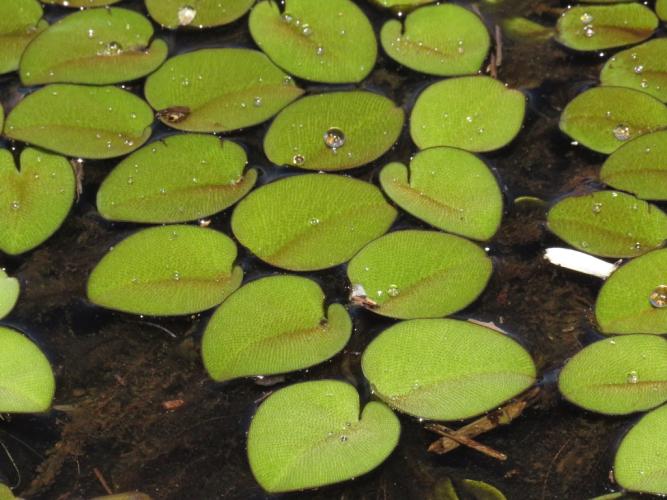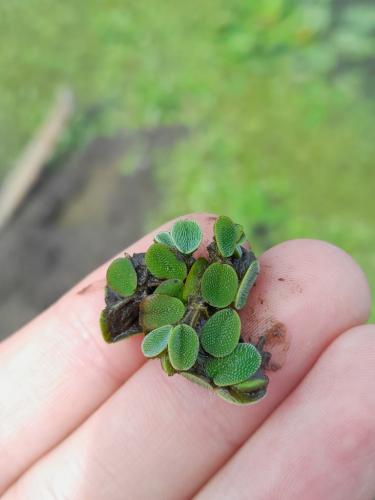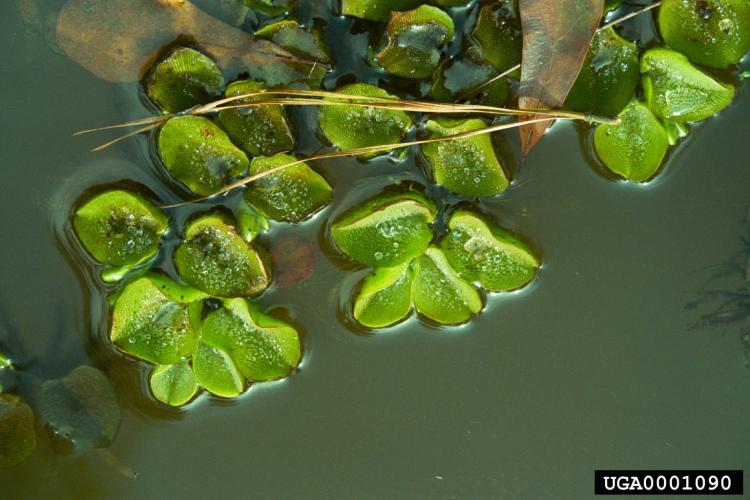Giant salvinia
Identification
Appearance
Giant salvinia is a free-floating aquatic plant that that produces leaves grown along a horizontal stem. Along the stem, leaves grow in whorls of three, with two emergent leaves and one submerged leaf, which acts as the plant’s root structure. Giant salvinia produces chains of the whorled leaf ‘plantlets,’ which can spread to create dense mats covering immense areas.
Foliage
Giant salvinia leaves grow in whorls of three, with two emergent, and one submerged leaf. The emergent leaves are ovate and 1-4cm long. They have a prominent central rib, causing an upward crease in some leaves. The emergent leaves are bright green and are covered in small, white hairs (papillae). The hairs are slightly bulbous and hollow at their termina and resemble eggbeaters. These hairs give the leaves a fuzzy feel, and act as a hydrophobic layer. The submerged leaf is split into many fiber-like lengths that can grow up to 25cm and are brown in color. They resemble roots and serve a similar function.
Biology
Habitat
Giant salvinia grows in slow moving and stagnant waters such as canals and ponds. It is most productive where there is high nutrient availability, and in waters between 20-30C, although it can survive in a wider range. It does not survive ice formation, save for in well-established populations, and cannot survive salinity over 7 parts per thousand. Buds are killed when frozen, or when exposed to temperatures above 43C.
Life Cycle
Giant salvinia is in the fern family, members of which generally reproduce using spores. However, giant salvinia’s spores are sterile, so it is only able to reproduce vegetatively, through fragmentation. Fragments split off from the main stem and sprout new growth from attached nodes or the broken stem end. The process happens quite rapidly, as giant salvinia is able to double its biomass in 4-10 days under optimal growth conditions. In tropical climates this growth can continue year-round, but in temperate regions, giant salvinia dies back in freezing temperatures, and only lower layers of protected biomass survive. When temperatures increase, growth and fragmentation resume.
Ecological Threat
Giant salvinia spreads to create dense, thick mats that limit light penetration underwater. This, combined with giant salvinia’s strong ability to spread vegetatively, can result in the loss of native aquatic vegetation, and the creation of a monoculture. Mats of giant salvinia also result in decreased dissolved oxygen levels, as dying plant matter consumes available reserves. This decreases habitat suitability for aquatic animals and plants. Giant salvinia mats also clog waterways, impeding agricultural, recreational, and transportational activities. This is a large risk in rural regions where waterways are relied on as a primary source of transportation and income.
Vermont Distribution
Giant salvinia is not currently present in Vermont.
How You Can Help
For most aquatic invasive species, humans are the primary vector of transport from one waterbody to another. Many of these nuisance plants and animals can be unknowingly carried on fishing gear, boating equipment, or in very small amounts of water in a watercraft. The easiest and most effective means to ensure that you are not moving aquatic invasive species is to make sure that your vessel, as well as all your gear, is drained, clean, and dry.
CLEAN off any mud, plants, and animals from boat, trailer, motor and other equipment. Discard removed material in a trash receptacle or on high, dry ground where there is no danger of them washing into any water body.
DRAIN all water from boat, boat engine, and other equipment away from the water.
DRY anything that comes into contact with the water. Drying boat, trailer, and equipment in the sun for at least five days is recommended. If this is not possible, then rinse your boat, trailer parts, and other equipment with hot, high-pressure water.
Citations
Photo Credit
0001090: Scott Robinson, Georgia Department of Natural Resources, Bugwood.org
5079042: Troy Evans, Great Smoky Mountains National Park, Bugwood.org
Renata Xavier
Julien Piolain
Information Credit
Giant Salvinia (Salvinia Molesta). US Fish & Wildlife Service, 2015.
“Giant Salvinia Control | U.S. Fish & Wildlife Service.” FWS.gov, US Fish & Wildlife Service, 2015, www.fws.gov/project/giant-salvinia-control.
“How to Control Giant Salvinia - AquaPlant: Management of Pond Plants & Algae.” AquaPlant, Texas A&M AgriLife Extension, aquaplant.tamu.edu/management-options/giant-salvinia/.
USGS. “Giant Salvinia (Salvinia Molesta) - Species Profile.” Nas.er.usgs.gov, United States Geological Survey, 8 Feb. 2016, nas.er.usgs.gov/queries/FactSheet.aspx?speciesID=298.


